
Explore Busan
Busan, the second largest city in Korea, is a bustling city of approximately 3.6 million residents. It is located at the southeastern tip of Korean peninsula with a size of 769.82km2 covering 0.8% of the whole land. The natural environment of Busan is a perfect example of harmony between mountains, rivers and sea. Its geography includes a coastline with superb beaches and scenic cliffs, mountains which provide excellent hiking and extraordinary views, and hot springs scattered throughout the city. Busan enjoys four distinct seasons and a temperate climate that never gets too hot or too cold. Its deep harbor and gentle tides have allowed it to grow into the largest container handling port in the country and the fifth largest in the world. The city's natural endowments and rich history have resulted in Busan's increasing reputation as a world class city of tourism and culture, and it is also becoming renowned as an international convention destination.
City Environment
Busan, a city of beautiful mountains, rivers and the sea, is also a important cultural city. With the Nakdonggang River bordering the city and superb natural scenery like Haeundae adding nationwide attraction, the city serves as a major nexus of cultural activities around the region. Also, Busan is the first international port city in Korea. Its location enables the city to serve as a main gateway for the Korean Peninsula and the entire Northeast Asian region.
Location
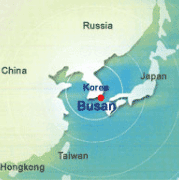
Busan Location Geographically, Busan has the Straits of Korea to its south; Ulsan to the north;Gimhae to the West. Cities that share almost the same latitude with Busan include Jinhae and Gwangju in Korea, as well as Tokyo, Jeongsen, Algiers and Oklahoma City abroad. Busan is eight hours ahead of GMT. As for its geopolitical location, the city comes at the Southern tip of a strip that connects Asia, Siberia and Europe. It also serves as a main gateway to the Pacific Ocean. This location places the city at the center of international sea transportation.
Population
From its opening in 1876, the port city of Busan quickly developed into a hub of trade, commerce and industry. This development resulted in a rapid increase in its population, which had already reached 200,000 by 1936. A major leap in Busan's population came with the breakout of the Korean War, which resulted in an endless stream of people into the city. As a result, the population of Busan exceeded 1 million by the end of 1955. Another factor that spurred the population increase was the government policy for economic growth. People from urban areas kept streaming into the city for jobs. By the end of 1994, there were approximately 4 million people who called Busan their home. Since 1995, the population has slowly begun to decrease. As of December 2014, Busan was home to 3,557,716 people.
History of Busan
The first human presence on the Korean Peninsula can be traced back as far as the Paleolithic Age. Most of the ruins and remains in the Busan area to date are from the period after the beginning of the Neolithic Age. The well-known remains of the Neolithic Age in Busan are shell mounds and these are all consistently located near rivers or the sea. It appears therefore that our ancestors' life centered around fishing. Since 1950, Busan emerged as a leading base for the economic rehabilitation and democracy of Korea. For more information of Busan, please visit Busan Museum, Dongsam-dong Shell Mounds, Bokcheon Museum, Chungnyeol Shrine, Baeksan Memorial Hall and the many other historical facilities in Busan. Make the most of Busan's cultural heritage, to really enjoy your time here.
Bronze Age communities in Busan used no patterned earthenware. The Bronze Age had a great effect on the ensuing development of the Japanese Yayoi Culture. Most ruins and remains from the Iron Age(throughout the Three Hans period, Gaya and the beginning of the Three Kingdoms) are shell mounds and old tombs. Shell mounds and old tombs are found range throughout Jodo, Yeongseon-dong, Dadae-dong, Goejeong-dong, Dongnae Nakmin-dong, Oryundae, Hwamyeong-dong, Geumsa-dong, and Bokcheon-dong. There are many more old tombs of the Busan region dating from the Iron Age compared to other regions. Since the place for refining iron was discovered in Dongnae shell-mounds, excavations have shown that Busan was the central production area for Iron. It is also apparent that refined iron from here was exported to Japan, Naglang ,Dabang and other regions by means of the Suyeong River. These facts are recorded in the "Wui History" chapter of the "History of the Three Kingdoms of China“. After this period, there was a historic shift towards the area around the Suyeong River and Oncheon stream.
According to studies of literature during that period, small territories such as Geochilsanguk and Dokloguk were influential. In the middle of the 6th century the Silla Kingdom annexed Gaya. After the name for the Busan region was changed from Geochilsanguk to Geochilsangun, in the reign of King Gyeongdeock(757) it was changed again from Geochilsangun to Dongnaehyeon. At that time Dongnae appeared for the first time in historical records. In the Goryeo Dynasty, the Busan region continue to use the administration system of Silla. In the middle of the Goryeo dynasty, during the reign of King Injong, the family of Dongnae Jeong rose to a position of power in central politics but faced new challenges. A party feud and a sense of entrapment between the central political power and the Jeong family occurred, Jeongseo was demoted and forced to return home. After retreating to the Dongnae area Jeongseo set up the pavilions and composed the poem “Jeong-gwajeong-gok” that recited faithfulness and integrity. Jeong-gwajeong-gok is the one of the best poems in Goryeo Literature and is widely accepted as the origin of Busan literature itself. On the other hand, Busan's military importance was emphasized more strongly. A fortress was built in Busan to station troops in defence against Japan's expanding power.
In the Joseon Period during the reign of King Taejo, the administrative boundary (jin) around Dongnae was established. Later, in the reign of King Taejong, the "Daeil Gyoyeokjang"(trading center) was also established, in 1470 thus expanding trade between Joseon and Japan. At the same time, Dongnae’s role in defence and diplomacy was becoming increasingly important. In 1592, the Imjin War highlighted the need to forge a new and better relationship for Korea and Japan. After the Imjin War, efforts were made at improving relations. This allowed for the establishment of a trading system and the sending of delegations between Korea and Japan. During the late Joseon Dynasty, Choryangwaegwan was the only office trading between Joseon and Japan. It was also the place for establishing trade links between the Eurasian Continent and the Far East. It should not be forgotten, however, that the combined spirit of the anti-Japanese struggle and national salvation bravely shown by citizens and soldiers alike has been handed down to us today and has subliminally permeated the collective subconscious of our rights as citizens. In the 19th century, Busan's anti-Japanese struggle against an imperialist Japan was stronger than that of any other region. Many patriots, students, laborers and kisaeng entertainers alike, participated in the movement to resist Japan.
With the end of World War II, the restoration of independence took place on August 15th, 1945. At the start of the Korean War, Busan became an enormous city of refugees, and, as the last bastion of national power, the provisional capital. Busan was upgraded to a “Jikhalsi” (city under direct control of the government) in 1963 and a metropolitan city in January, 1995. From the 1950s to the 1980s, Busan emerged as a leading base for the economic rehabilitation and democracy of our nation. However, increased foreign competition in the 1990s and the Asian Financial Crisis forced Busanites to show their toughness in the face of economic adversity. After passing through a long, dark tunnel, Busan is beginning to emerge stronger and better than ever. For reference, please visit Busan Museum, Dongsam-dong Shell Mounds, Bokcheon Museum, Chungnyeol Shrine, Baeksan Memorial Hall and the many other historical facilities in Busan. Make the most of Busan's cultural heritage, to really enjoy your time here.
Haeundae Beach
Haeundae boasts an ideal wide, sandy beach and shallow waters with gentle ripples. Upon hearing 'Busan', 'Haeundae' is the first to spring to mind, and it surely is the city's representative spot. In particular, with the buildings and upscale hotels along the shoreline, the beach is well-known for its modern feel.
- Available period : June 1st-September 30th
- Getting there: Subway line 2 to Haeundae Station (Exit 3 or 5) → 600m in the direction of Haeundae seaside.
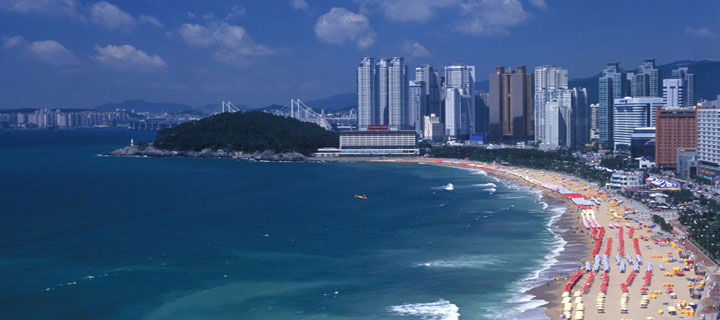
Jagalchi Market
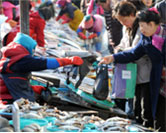
A place where freshly caught fish is bought and sold. The first floor of the building is the fish market while the second floor has a raw fish center and a dried seafood section. Fresh fish can be bought for comparatively low prices, and an economical meal can be enjoyed by buying the fish from the market and then taking it upstairs to the raw fish center where it can be prepared for just a small additional cost to cover seasonings and maeuntang(spicy fish soup).
- Opening hours: 02:00-22:00
- Getting there: Subway line 1 to Jagalchi Market (Exit 10) → Jagalchi 1-gil → Entrance to Jagalchi Market
Gukje Market
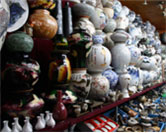
This market is a reminder that Busan was once the largest trade city in Korea. Gukje Market is large in scale and including various foreign items, a vast array of goods are offered at bargain prices.
- Opening hours: 09:00-20:00
- Getting there: Subway line 1 to Jagalchi Market Station (Exit 7) → Nampo intersection → BIFF Square, 300m in the direction of Gwangbok-ro
BIFF Square
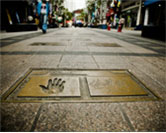
The first Busan International Film festival in 1996 was the first of its kind in Korea. Since then BIFF has grown to become the world's most dynamic film festival and Asia's largest festival. The BIFF Square is at the center of the 4 movie theaters in Nampo-dong and is a combined entertainment space for movie-watching and shopping. It is also called 'Star Street' for its circular stage and the handprints of famous movie industry celebrities.
- Getting there: Subway line 1 to Jagalchi Station (Exit 7) → Nampo intersection → BIFF Square, 300m in the direction of Gwangbok-ro
Busan Tower
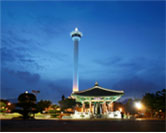
The second highest lighthouse in the world, Busan Tower was erected in 1973 at an altitude of 69m and height of 120m. It was based on the design of a lighthouse, and the top of the tower was modelled after the top of Bulguksa's Dabotap in Gyeongju. The observation deck affords spectacular views of the city, particularly at night.
- Opening hours (April-September: 08:30-22:00, October-March: 09:00-22:00)
- Admission fee charged
- Getting there: Subway line 1 to Nampo Station (Exit 1) → 200m in the direction of Gwangbok-dong Fashion Street → Yongdusan Park → Take the escalator
Taejongdae Resort Park
Taejongdae was named after the 29th king of Silla Dynasty King Taejong Muyeol(Kim Chun-chu). While traveling around the country, King Taejong got attracted to this spot with its rugged cliffs surrounded by dense pine forests and the sea. He enjoyed shooting arrows here. Taejongdae is abundant in its cliffs which seem as if they have been trimmed by the sea, and uniquely-formed rocks believed to have been formed during the 4th interglacial period 120,000 years ago. The breathtaking views here enable visitors to appreciate Busan's natural history.
- Getting there: Subway line 1 to Nampo Station (Exit 6) → Change to bus no. 66, 88, or 101 → Alight at Taejongdae Park
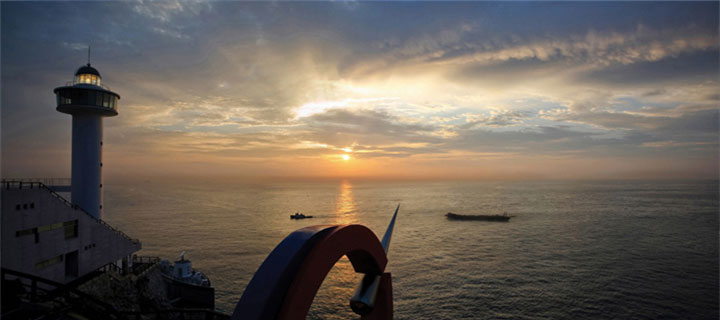
Shinsegae Centum City Department Store
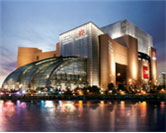
The Shinsegae Centum City Department Store is registered in the Guinness Book of World Records as the world's largest department store. Not only does it contain clothes stores and eateries, but it is also the only place in Busan where shopping can be enjoyed along with an indoor ice rink, golf range, CGV movie theater and Spa Land which offers relaxation in the middle of the city, with views of the Suyeong River and the sea. This is a combined shopping and entertainment complex which can be enjoyed throughout the year.
- Opening hours: Weekdays 10:30-20:00, Weekends 10:30-21:00
- Getting there: Subway line 2 to Centum City Station (Exit 12)
UN Memorial Park
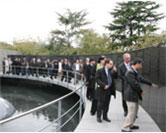
The UN Memorial Park is the only cemetery honoring UN soldiers, commemorating the 2300 soldiers from 11 countries who sacrificed their lives during the Korean War for world peace and freedom. The park contained within has more than 600 types of trees.
- Opening hours 9:00-17:00 (last entry 16:30), Summer (May-September) 9:00-18:00, (last entry 17:30)
- Getting there: Subway line 2 to Daeyeon Station (Exit 3 and 5) → 600m straight in the direction of the UN Memorial Tower 600m until you see Busan Museum on the right → 400m in the direction of the UN Memorial Cemetery
Busan Cinema Center
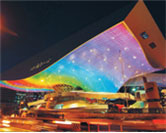
A place where cinema fanatics gather. The center has held special screenings of major directors and genres, introducing the public to high quality art house movies and at the same time bringing locally produced independent movies to people. The asymmetrical big tube cantilever roof with 120,000 LED lights and measuring 85m in length boasts spectacular night views.
- Opening hours - 10:00-19:00
- Getting there: Subway line 2 to Centum City Station (Exit 6 or 12) → Walk 5 Minutes Nurimaru
Nurimaru APEC House
Since the APEC Summit Meeting in 2005, the Nurimaru APEC House has been the host of high quality international conferences and today the popular tourist spot still sees a daily 4000-5000 visitors. The Korean name 'nurimaru' means 'summit of the world' and the building is modelled on the traditional Korean jeongja, or pavilion. Visitors can feel the presence of the summit meeting inside the building.
- Opening hours: 09:00-18:00
- Getting there: Subway line 2 to Dongbaek Station (Exit 1) → 800m in the direction of Busan Westin Chosun Hotel → Inside Dongbaek Park
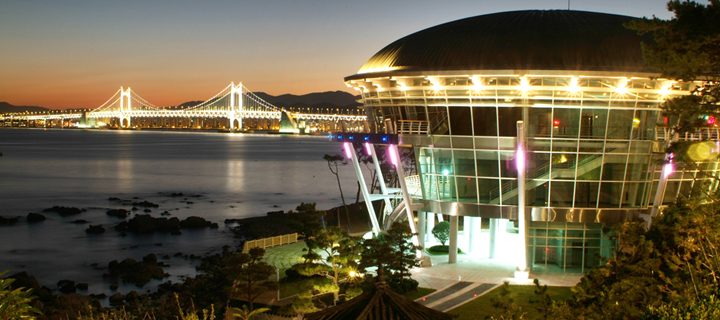
Dalmaji Hill
Located just beyond Haeundae, Dalmaji Road is a small, serene walkway at the corner to Songjeong Beach (on the slope of Wausan, or Mount Wau) and has a treasure of beautiful cherry blossoms and pine trees. During the nights of full moon, the moon gently reflects off the sea offering perfect views. The many modern art galleries and pretty cafes give the place its nickname of 'Culture Street'.
- Getting there: Subway line 2 to Jungdong Station (Exits 5 or 7) → 500m in the direction of Mipo intersection
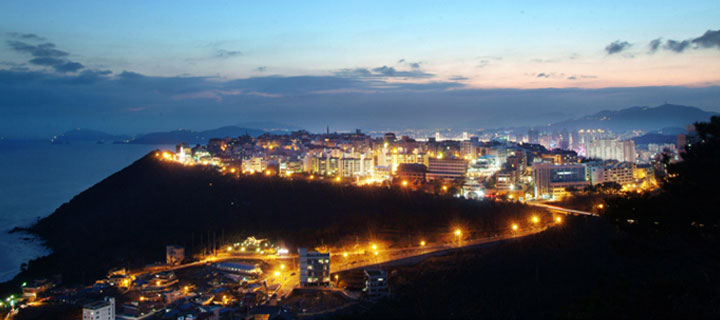
Mount Hwangnyeong Night Scenery
Mount Hwangnyeong boasts spectacular views and is the popular spot well-known for night hiking. With its amazing scenery of the city's buildings lights and the lights of the Gwangan Bridge reflecting off the waters beneath, the spot is considered a 'must-see' for visitors. The observatory located halfway up the mountain embraces Haeundae, the city and the surrounding sea in one gaze.
- Getting there: Subway line 2 to Namcheon Station (Exit 4) → Take bus no. 38 → 700m in the direction of Mount Hwangnyeong
Gwangan Bridge
Gwangan Bridge stretches over 7.4km and is the largest bridge over the ocean in South Korea. The bridge showcases wonderful night views and the upper part of the bridge captures the scenery of the sea and nearby cities.
- Getting there: Subway line 2 to Gwangan Station (Exits 3 and 5) → 700m in the direction of Gwangalli Beach
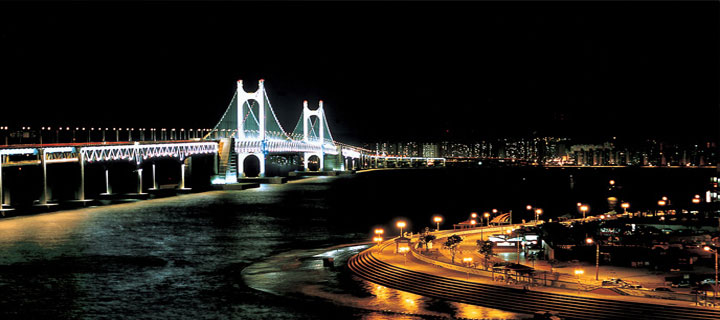
SEA LIFE Busan Aquarium
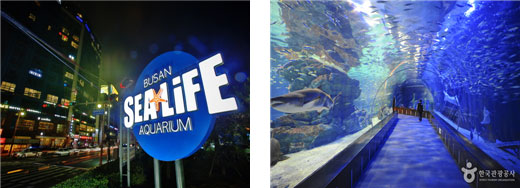
The Busan Aquarium contains over 35,000 species of fish, algae, reptiles, and amphibians. This state-of-the-art facility is one of the Korea’s top aquariums.
The aquarium covers an area of 36,000 m2 and is spread over 3 underground levels and features an outdoor park.
On the first underground level is a souvenir shop and several places to eat, while the B2 and B3 levels showcase the various exhibits. The third underground level boasts an 80m main (seabed) tunnel.
The tunnel experience resembles a walk along the ocean floor with various sea creatures swimming above. This is a very popular area of the aquarium and is sure to amaze visitors. The simulator also stimulates the imagination and provides a unique feeling of life on the ocean floor.
- Opening hours: 10:00-19:00
- Getting there: Subway line 2 to Haeundae Station (Exit 3 or 5) → Walk 10 Minutes
Busan Gamcheon Culture Village
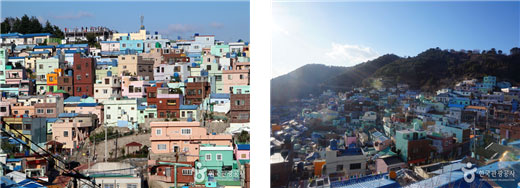
Gamcheon Culture Villiage, as shown below, lead to the village's cultural houses formed in the cascade foothills area. The village was recreated by local residents as a place where you can enjoy the sights.
- Opening hours: 09:00-18:00
- Getting there: Subway line 1 to Goejeong Station (Exit 6) → Take Bus(Saha No.1, No.1-1)
Haedong Yonggungsa Temple
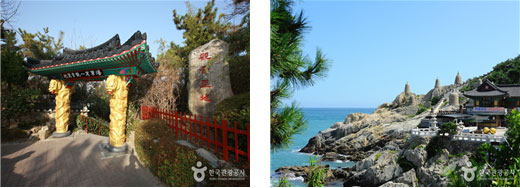
Haedong Yonggungsa Temple is situated on the coast of the north-eastern portion of Busan. This superb find of a tourist spot and temple offers visitors the rare find of a temple along the shore line. Most temples in Korea are located in the mountains. Haedong Yonggungsa Temple was first built in 1376 by the great Buddhist teacher known as Naong during the Goryeo Dynasty. Many people often come to this spot on New Year's Day to make a wish for the new year as they watch the sun come up. April is an especially beautiful time of year with cherry blossoms in full bloom. The birth of Buddha is also celebrated in April (following the lunar calendar) and offers a spectacular night view as the temple area is aglow with electrically lit lanterns.
- Opening hours: 04:00 - Sunset
- Getting there: Subway line 2 to Haeundae Station (Exit 7) → Take Bus No. 181






